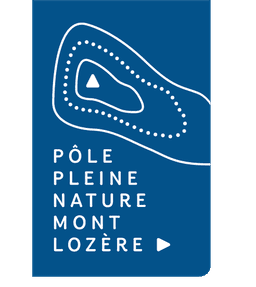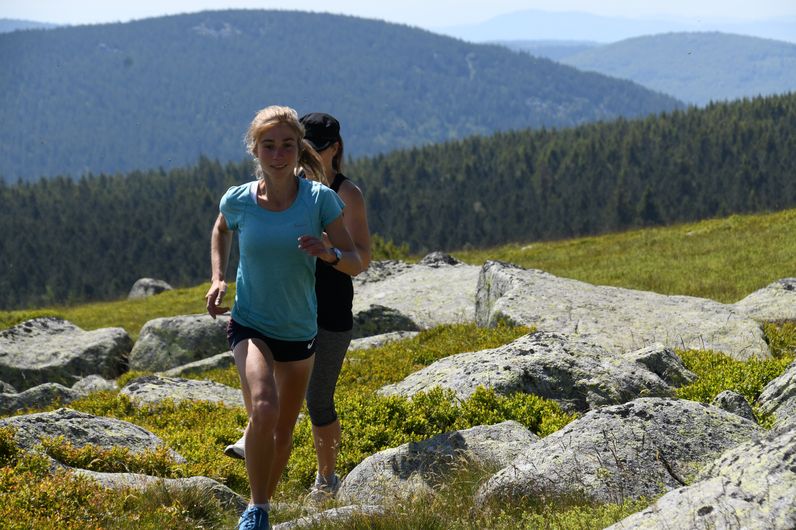
Summit of Finiels and Pelouse, variant Trail #17v
10 points of interest

 Flora
FloraOther short-grass prairies?
Marker 7
After the forest, which is a farmed and worked space, foresters clear areas such as here, where other plant communities establish themselves: peat bogs, meadows, track verges. On the return leg, two large grasses will attract your attention: great yellow gentian with its yellow flowers and a more recent arrival, rosebay willowherb (fireweed), whose fruit “explode” into cottony masses at the end of the summer, when ripe.
 Pastoralism
PastoralismDown in the valley
Marker 6
The hamlet of Finiels shelters both humans and livestock during the winter. Crop land is subjected to the treatments of modern agriculture. Since the mid-20th century, bovines have slowly replaced sheep and live on fenced-in broom heaths. These pastures are very different from those provided for sheep. Cows do not graze moorland undergrowth.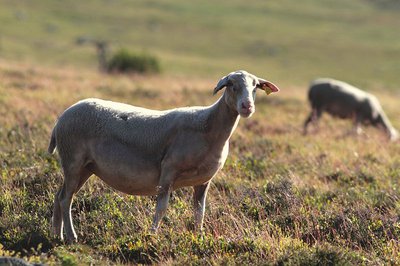
Mouton transhumant, Col de Finiels - © Jean-Pierre Malafosse  Pastoralism
PastoralismThe sheep reigns
Marker 5
In the late 19th century 100,000 sheep grazed Mont Lozère’s pastures every year. In the summer, there was intense traffic here. In fog, montjoies (standing stones or cairns) still guide travellers, as they did the famous Scottish writer Robert Louis Stevenson and his donkey Modestine. Today, just over 8,000 sheep, divided into flocks each of which is kept by a shepherd, use the summer pastures on the Mont Lozère. They now share the massif’s 6,000 hectares of short-grass prairies and heath with cattle (in pens).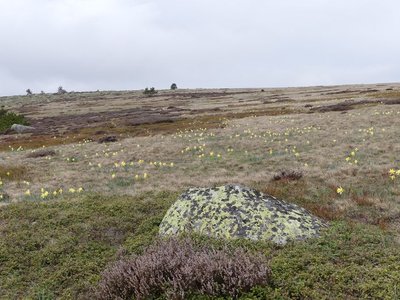
Finiels - N.Thomas_pnc  Flora
FloraFiniels summit
The short-grass prairie consisting of a coarse grass species called matgrass adapts to harsh weather conditions at altitude. In the spring, wavy snow dunes form in some hollows; small heaps seek shelter behind shrubs. The Eurasian skylark, meadow pipit and common linnet already try to cross the summit by fluttering close to the ground. On the summit itself, some islands of callune (heather, which has the particularity of flowering first at altitude) and some blueberry plants manage, with great difficulty, to establish themselves. Boundary stones have Maltese crosses carved into them. In the 12th century, Baron de Tournel gifted land located on the southern slopes of Mont Lozère to the Knights of Saint-John of Jerusalem. In the 16th century, this order became the Order of the Knights of Malta. The commandery was set up at L'Hôpital and its land delimited by these boundary markers.
 Flora
FloraThe prairie's botanical rivals
Marker 4.
Below you, vast areas have been planted with pines and other conifers. The interest and regional and European rarity of short-grass prairies mean that they must be clearly demarcated from the forest. In fact, natural seeding of pines, carried onto the prairie by the south wind, has created a new forest. This plant dynamic, which is entirely logical at the altitude, gives the forest the upper hand over the prairie. The European Union is currently helping local participants to fell these new trees so as to protect the prairie. On your return leg, you will see other indigenous tree species which could encroach on the prairie in the same way (beech, birch).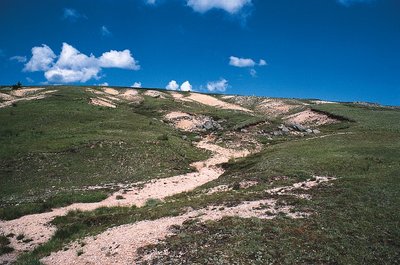
Érosion, passage des transhumants - © Parc national des Cévennes  Landscape
LandscapeAn endangered landscape
Marker 3
This vast expanse of short-grass prairie, an area of historical and natural heritage, is endangered today. The surface area of this relic has been much reduced over the past few decades. While the summits are made stable by the prairie, the mountain side presents evidence of erosion (denuded rocks) that is the result of foresters’ attempts at reforestation. On the ledge, pines are starting to establish themselves at the expense of the prairie. These zones have become fragile and need better management of all the territory’s elements. Shepherds will have to guide their flocks carefully here, so as to avoid making erosion worse but also to eliminate pine seedlings.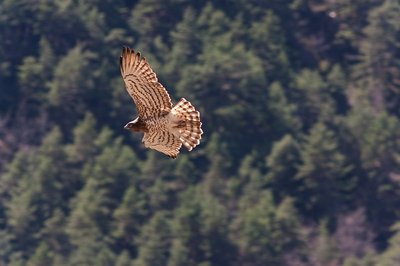
Circaète Jean le Blanc - © Jean-Pierre Malafosse  Fauna
FaunaBirds
Vertebrates benefit from the plants or from small prey, especially hares or the common lizards with its thick tail, which is coveted by the reptile-eating short-toed snake eagle. Among the birds of prey, you may spot the characteristic silhouette of a Montagu’s harrier or hen harrier, with their low contour-hugging flight. Among the many passerines, you may spot the Northern wheatear, a summer guest, sitting on a stone, or more rarely a grey partridge. If you listen, you may well hear larks singing.

 Flora
FloraLow-growing plants and shrubs
A large amount of sunshine encourages many low-growing grasses from other botanical families to appear among the fescue and nard. They are almost all perennial. They form a veritable tangle of plants. Among the pretty alpine flowers are the spring pasque flower and the blue dwarf spring gentian in summer. Other, smaller plants are perfectly capable of “making holes” in a short-grass prairie that is less intensely grazed than before. Grass networks that lose in density develop weak points that shrubs exploit to grow at the very heart of the prairie: blueberries, which are here associated with lingonberries (cowberries) and calluna, a type of heather.
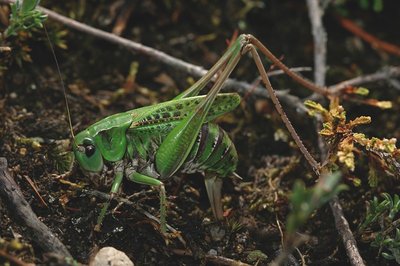
Dectique verrucivore (Decticus verrucivorus) - © Bruno Descaves  Fauna
FaunaSmall grassland creatures
Marker 2
Each spring, a demographic explosion of fauna prepares itself to burst forth in the summer. Earlier in the year, the thousands of small creatures to be seen here have not yet finished their metamorphoses, and the various species are difficult to recognise as larvae. Subalpine short-grass prairies attract a specific mountain fauna that is getting rarer everywhere else in Europe, such as the Stauroderus scalaris cricket, which tirelessly enlivens the pastures with its summer concerts. Crickets only eat plant matter whereas grasshoppers, such as the wart-biter, tend to be carnivorous. Many butterflies visit the flowers.
Paysage - © Brigitte Mathieu  Flora
FloraSubalpine short-grass prairie
Marker 1
Like garden or sports pitches, short-grass prairies are shaped by mankind. Grazing and controlled burns are the tools for their maintenance here. The main plants are nard and fescue, perennial grasses related to wheat. If you cut (graze) one of their stalks, five more will soon form; if you trample them, they multiply and become very dense. This kind of “torture” creates a thick plant cover that stabilises the sparse dark soil, which is derived from erosion of the ever-present granite. Here, then, are some clues for the appropriate management of this environment, which becomes weakened if neglected.
Description
Then a short steep part on a path to reach the summit of Finiels (1,699 metres, the highest point in Lozère). Finally a pleasant descent on “the path less travelled” through forest and pastureland.
Follow the waymarks for #17v.
Signposts will guide you all along this route, as well as yellow painted waymarks. In the description below, the signposted place names and/or directions are given in bold italics between quotation marks:
From "Col de Finiels", take "Bas du Col Plat", "Col Plat" and "Font de Sénebébios".
At "Font de Sénebébios", head for "Sommet de Finiels" via "Col de la Draille", "Valat de la Mouline" and "Route Forestière des Crêtes".
At the summit of Finiels, return to "Col de Finiels" via "Col de la draille" and "Sous le col de Finiels".
This hike is taken from the guidebook Mont Lozère – Pays des sources, published by the Pôle de pleine nature du mont Lozère.
- Departure : Col de Finiels pass
- Arrival : Col de Finiels pass
- Towns crossed : Mont Lozère et Goulet, Pont de Montvert - Sud Mont Lozère, and Cubières
Forecast
Altimetric profile
Recommandations
Caution: livestock guard dogs (patous) in the Cassini area !
Seek advice on how to behave near these dogs from tourist offices and National Park information centres.
Before committing yourself to a circuit, ensure that it is suitable for your activity level and ability. Remember that the weather changes quickly in the mountains. Please close all gates and barriers behind you. Stay on the marked path.
Information desks
Tourism office Coeur de Lozère, Mende
BP 83, place du Foirail, 48000 Mende
This office is part of the National Park's associated tourist-information network, whose mission is to provide information on, and raise awareness of, the sites and events as well as the rules that must be observed in the National Park's central zone.
Open year-round
Office de tourisme Des Cévennes au mont Lozère
le Quai, 48220 Le Pont de Montvert sud mont-Lozère
Tourism office Mont-Lozère, Bagnols-les-Bains
avenue de la gare, 48190 Bagnols-les-Bains Mont-Lozere et Goulet
This office is part of the National Park's associated tourist-information network, whose mission is to provide information on, and raise awareness of, the sites and events as well as the rules that must be observed in the National Park's central zone. Open from mid-April to late September
Access and parking
From Le Bleymard, to Station du Mont-Lozère on the D 20.
Parking :
Calculateur d'itinéraire Lio
Utilisez le calculateur liO pour organiser votre trajet en région Occitanie.
Autres régions
Calculez votre itinéraire en Auvergne Rhône Alpes sur Oùra
Biodiversité autour de l'itinéraire
Source


Report a problem or an error
If you have found an error on this page or if you have noticed any problems during your hike, please report them to us here:




